Sunday, October 29, 2006
Public Art
The road to the provincial government building was mostly nondescript, but there was one rather ramshackle building with all sorts of secondhand stuff on the porch, presumably for sale. The one piece of secondhand stuff that I remember was a garish gilded statue of a nude woman.
But she wasn't the tackiest part of the house. Sitting on the roof of the house was a pink statue of a pig, sitting like a porcine "The Thinker" (his nude body was human from the neck down), with a scowl on his face as he looked down on the street. The fact that Suwon is known for its rib dishes is the only tenuous connection I can make to make the pig anything less than inexplicable.
Suwon
Also, there's a little park within the fortress walls with a March 1 1919 (analogous to July 4, 1776 in the USA) memorial and some benches. It's a very quiet place, considering it's surrounded by city on all sides. I didn't take my camera, but that means I could focus on the moment rather than take pictures for later.
Friday, October 27, 2006
Equal pay for equal work?
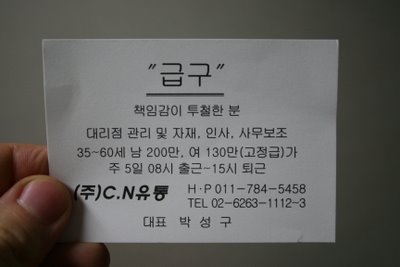 This is a "Help Wanted" ad for what looks like a routine office admin job. I'm curious about the explicitly different salaries for men and women. This ad says they'll pay 2,000,000 won/month to men and 1,300,000 won/month to women. I know this country is widely considered to be far less committed to the ideals of sexual equality than most Western countries, but still I'm suprised at the sheer directness of this ad. They don't even try to claim they want men and women for different jobs. They want men or women for the same job, but they'll pay men a lot more. Am I misunderstanding something here? Or is there some cultural issue I don't know about?
This is a "Help Wanted" ad for what looks like a routine office admin job. I'm curious about the explicitly different salaries for men and women. This ad says they'll pay 2,000,000 won/month to men and 1,300,000 won/month to women. I know this country is widely considered to be far less committed to the ideals of sexual equality than most Western countries, but still I'm suprised at the sheer directness of this ad. They don't even try to claim they want men and women for different jobs. They want men or women for the same job, but they'll pay men a lot more. Am I misunderstanding something here? Or is there some cultural issue I don't know about?Again, I'm cynical enough I'm not shocked that they'd pay men more - I'm just shocked that they'd be so upfront about it.
Wednesday, October 25, 2006
Change of seasons
But I gained new appreciation for Korea's 4 seasons last weekend, when summer belatedly ended and fall began. I'm used to it being a gradual process. Not this time. The balmy unseasonable warmth we'd had ended when the sun went down on Saturday. Sunday was a misty rainy day, and Monday was a day of low temperatures and strong winds. Obligingly, the leaves began to fall from the trees. I've never seen such a well-defined break between seasons.
Sunday, October 22, 2006
Happy Chuseok!
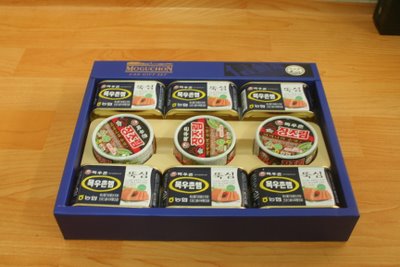
Canned ham!
This is not an unusual Chuseok gift here. On the previous Chuseok I spent in Korea, my boss gave me a big gift set of soap, shampoo, and body washes. This spam is probably going to find its way into my stir-fry. It's a lot of ham, but I'm not in any hurry to eat it. The expiration date is January 1, 2009.
Choe Gyuha
Taipei VI
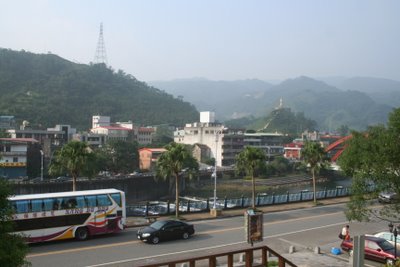 Jenna and I took a day to visit a village outside of Taipei that's famous for its local tea, and which even has a Tea Museum. And I've completely forgotten its name.
Jenna and I took a day to visit a village outside of Taipei that's famous for its local tea, and which even has a Tea Museum. And I've completely forgotten its name.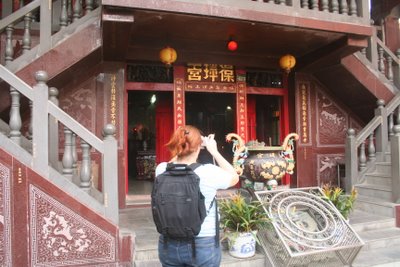 More in the series of Jenna taking pictures, this time of a temple in the aforementioned village.
More in the series of Jenna taking pictures, this time of a temple in the aforementioned village. 
A view from the top of the stairs in the previous photo.

Taipei V - Food Court
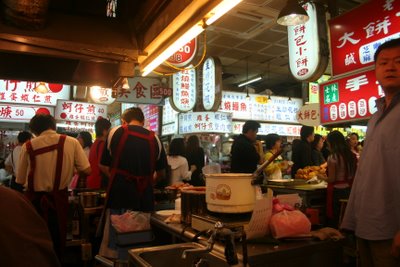 These are pictures of a food court at a night market (I forget the name) that Jenna and I visited.
These are pictures of a food court at a night market (I forget the name) that Jenna and I visited.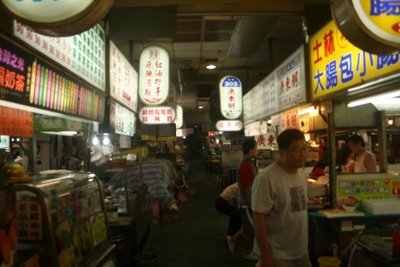 Jenna's recommendation was that I try an omelet dish with oysters. I did and it was excellent.
Jenna's recommendation was that I try an omelet dish with oysters. I did and it was excellent. 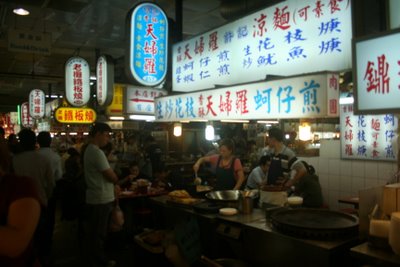
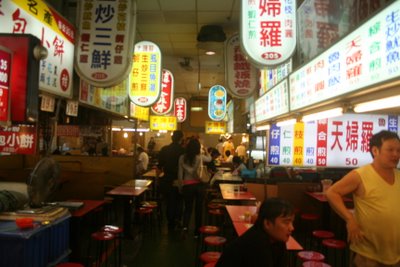
These pictures were taken in the late evening. I assume the food court stayed open for several hours afterwards... if it ever closes for the night.
Sunday, October 15, 2006
Cheonggyecheon - More of it
That said, I walked all the way from Dongdaemun to the vicinity of Sindap Metro Station. Once you get out there, Cheonggyecheon is no longer a trench cut through downtown Seoul, but is running through a neighborhood with a much more suburban feel. It's much wider, and has the feel of a real stream. At one point another wide stream feeds into it, in an area with gorgeous landscape architechture that I really should take pictures of. Nearby sections of the old Cheonggyecheon elevated expressway are still standing. It looks like ancient ruins.
But eventually my feet were killing me, so I turned off Cheonggyecheon and took the Metro back from Sindap. With more comfortable shoes and feet that have healed, I still plan to walk to the Han River sometime before winter.
By the way, more Taipei pics are coming, when I have time to upload them!
Saturday, October 14, 2006
Taiwan IV
 Military guard in front of Chiang Kai-shek Memorial Hall on Saturday.
Military guard in front of Chiang Kai-shek Memorial Hall on Saturday.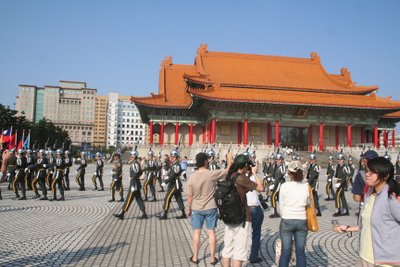
They went through their steps and marched for the audience - largely tourists.

Inside the Memorial Hall is a Lincoln Memorial-sized seated statue of Chiang Kai-shek. Despite having taken a course in Chinese history in college, I don't have much of an opinion about Chiang. The Taiwanese seem to see him as a "father of our country" type figure, but his rule was dictatorial and often extremely cruel, especially in the early years after he lost mainland China.
Taipei III - More Yehliu
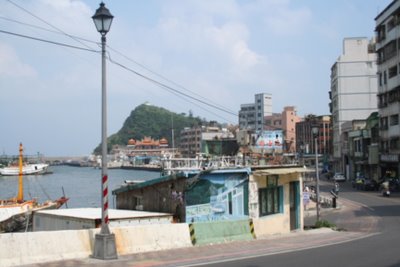 The little town of Yehliu, where Jenna and I had a very good seafood lunch.
The little town of Yehliu, where Jenna and I had a very good seafood lunch. 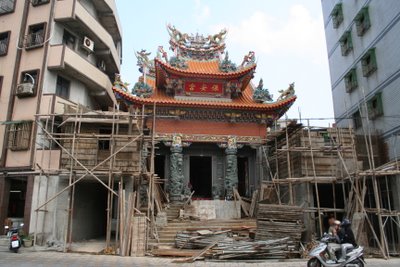
A temple in Yehliu, under construction.
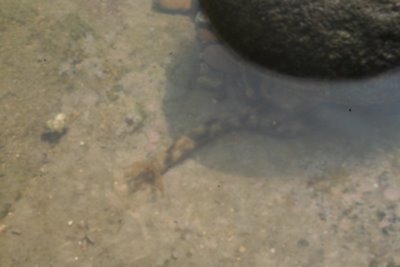
Any biologists out there? This little creature had us entranced for a good ten minutes, largely because we couldn't figure out what the heck it was. It was in a saltwater tide pool. It wasn't rooted to anything and could move (slowly), but didn't have much of a distinct head. It did have what seemed to be a mouth, surrounded by feather-like appendages that I suppose helped bring food in. My only guess is that it's some kind of sea cucumber; otherwise, it belongs to one of those myriad invertebrate phyla that few non-biologists have heard of. Any ideas?
Taipei II - Yehliu
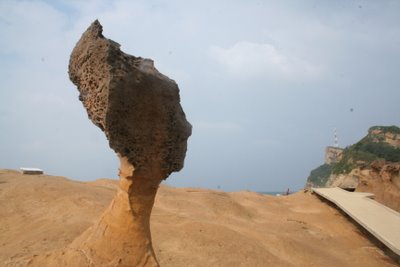
Widow's Head Rock. The local tourism authorities helpfully indicated the best spot on the ground to stand when taking a picture.
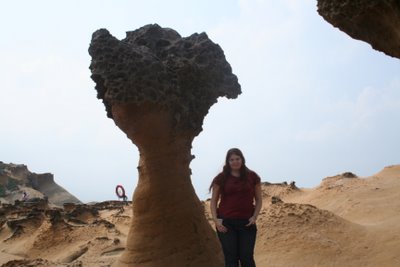
Jenna posing next to one bizarre looking rock - for size comparison.
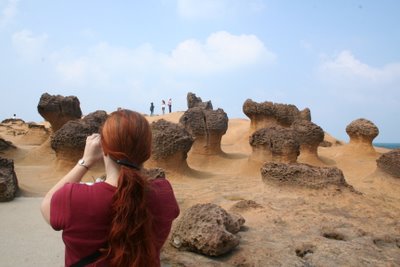
Taking pictures of people taking pictures.

The Yehliu coastline.
Taipei I
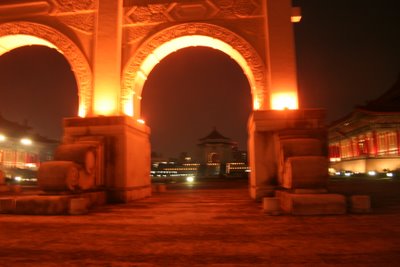
My initial impressions of Taipei - and these are mostly comparisons to Seoul:
- Taipei has a lot of motorbikes. Huge plagues of motorbikes. I used to think Seoul had plenty of motorbikes but... nope.
- Maybe it's just the week I went down, but Taipei's got some serious air pollution problems. Worse than Seoul, which is several times larger and which seldom wins accolades for the quality of its air. Maybe the motorbikes are the cause?
- The Taiwanese love dogs - of all shapes and sizes. As pets, not food. Living in Seoul, I'd gotten used to the fluffy little dogs that Koreans generally prefer as pets. But in Taiwan you regularly see all sizes of dogs out on walks (or walking around freely in small towns).

But I don't really have any impressions of the Taiwanese people. I talked to a very few of them, but I was only here from Wednesday to Sunday so I don't want to overgeneralize.
(By the way, in some of these pictures I accidentally had my camera on "manual focus" - if some of them look slightly blurry, that's why. Heck, maybe it improved them.)

I liked Taipei. I liked the food, I liked the crowds, and I liked the markets. I was able to overlook the air pollution. Of course, maybe this is partly due to the fact that I didn't have to work - and the weather was absolutely beautiful while I was there.

Tuesday, October 03, 2006
I'm off, almost
Already I'm curious about what EVA Air will give us to eat on the flight. When I flew from Incheon to Osaka one morning I got a nice little Bento Box-like cold meal. Quite nice. But when I flew from Incheon to Beijing I got a boring plastic-wrapped sandwich and a cup of juice.
When I flew Dulles to Heathrow aboard British Air, I ate a fairly ordinary chicken meal, while being tormented by the wonderful smells of the Indian meals being enjoyed by those people who had specified beforehand that they wanted vegetarian. Drat.
We'll see what EVA Air gives me.
로만아이재션
Already? Even now this country is awash with two quite different Romanization schemes. I hate typing Korean words in English because, quite unlike Japanese or even Chinese, there is NO universally agreed on system of Romanizing Korean words. Without getting into actual names of different Romanization schemes, there is an old system (Pusan, Taegu, Chongno, Kyongju with a doohickey above the "o") and a new system (Busan, Daegu, Jongno, Gyeongju, with no special characters).
Even this blog is not internally consistent. I spell the neighborhood where I spent most of my waking hours J-O-N-G-N-O (new system) but just a few entries below this one I mention Kangnam (old system) not Gangnam (new system). Why? Because I felt like it.
I'll agree that the "new system", which most guidebooks follow, can be confusing to pronounce for people who don't know Korean phonetics. The big Buddhist temple in Busan is called Beomeosa. That's pronounced "buhm-uh-sa." Not exactly intuitive. But look at Chinese Pinyin, which is pretty universal as a way of writing Chinese words. What Westerner would instinctively know how to say "c" or "x" in Pinyin words? Pinyin works because the Chinese government has been promoting it for decades, even getting the whole world to write "Beijing" and "Mao Zedong" rather than "Peking" and "Mao Tse-tung".
My only piece of advice for Korea: Pick a Romanization scheme, and stick with it. Don't change it after five years. You don't want half the English signs saying "Kyongju" and the other half "Gyeongju".